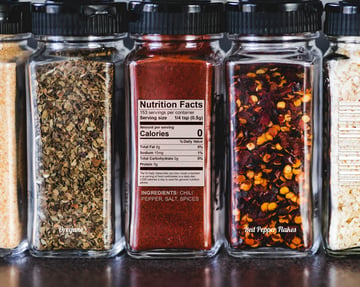As is tradition, the New Year brings with it new regulations from the FDA. To help you get started on the right foot, we’ve put together this short list of legislation that your business should consider going into the new year. And, if you’d like an even deeper dive into legislative changes, the FDA has released a new summary of recent and upcoming changes in their 2022 Food Code.
Want a quick and easy way to check if your business is ready for these upcoming regulations? Download our free resource: 2023 FDA Regulations Review Checklist!
1. Sesame allergen labeling deadline: January 1, 2023
Relevant legislation:
- The Food Allergen Labeling and Consumer Protection Act of 2004, also known as FALCPA, went into effect in 2006.
- The Food Allergen Safety, Treatment, Education and Research Act of 2021, also known as the FASTER Act, goes into effect on January 1, 2023.
The FDA requires 9 major food allergens to be labeled on all qualifying pre-packaged food. The FASTER Act added sesame (and its variations) to the list in 2021, with a compliance date of January 1, 2023. In total, 90% of food allergic reactions in the U.S. are caused by the allergens on the FDA’s mandatory declaration list:
- Milk (cow’s milk)
- Eggs (chicken eggs)
- Wheat
- Peanuts
- Soybeans
- Crustacean shellfish (with species identified)
- Fish (with species identified)
- Tree nuts (with species identified)
- Sesame
Undeclared (or mislabeled) allergens are the leading cause of food recalls, which is why it’s so important to have a complaint label. Food manufacturers have had a few years to adjust to the new sesame requirement. However, some may still be in the process of understanding the new rule, working through the steps of declaration, or be unaware of the presence of sesame in their products.
The seeds, leaves, and oil of sesame have been used by many cultures around the world, which means there are quite a few synonyms for the allergen. Some common variations include: tahini, bijan, ellu, geching, benne or benniseed, and more. Many items from pita chips to seasoning packets to falafels could contain hidden sources, so it’s important to thoroughly review ingredient lists and supplier spec sheets so you can stay compliant with FDA regulations.
Updated allergen guidance documents from the FDA
As this new regulation goes into effect, the FDA is also making some minor tweaks to their guidance documents on Food Allergen Labeling. In November, the FDA released two guidance documents (a draft and a final rule) titled “Questions and Answers Regarding Food Allergen, Including the Food Allergen Labeling Requirements of the Federal Food, Drug, and Cosmetic Act (Edition 5).”
The first document is a draft guidance with new questions and answers, and is open for public comment on the Federal Register until January 29, 2023 (docket ID: FDA-2022-D-0099). The second document is a finalized guidance with minor editorial changes and reorganization of previously published questions from Edition 4. The finalized guidance also includes label examples to help food manufacturers adjust to the current allergen labeling rules.
Allergen labeling best practices
Here are some tips from our labeling experts to help you stay compliant in 2023:
- Review ingredient lists and look for any Sesame alternative names.
- If an ingredient statement says spices, seasoning, or flavoring, double check for the presence of sesame.
- Review all ingredient lists from suppliers for sesame variations or hidden sources.
- Contact suppliers if clarification is needed on any ingredients.
- Review labeling guidelines on how to declare allergens, where to place the declaration, and the proper format and wording for compliance.
2. Food traceability, recordkeeping, and FSMA Section 204
Relevant legislation: The FDA’s Food Safety Modernization Act (FSMA), Section 204 (compliance date of January 20, 2026), and the Food Traceability List (FTL)
The final rule for FSMA Section 204 has been published, which sets additional recordkeeping requirements for foods on the FDA’s Food Traceability List. Any company that manufactures, processes, packs, or holds foods on the FTL will need to prepare for compliance with this new legislation.
The final rule is “designed to facilitate faster identification and rapid removal of potentially contaminated food from the market, resulting in fewer foodborne illnesses and/or deaths.” Companies will be required to incorporate key rules (including “Critical tracking events” or CTEs) into their operations to better track and reduce risk in the event of a food contamination.
For businesses that are impacted by the final rule, they will need to establish and document traceability plans to reflect how this information is being tracked. The FDA has also set these expectations once the compliance date arrives:
- If the FDA requests records, the business must provide them within 24 hours (or within a reasonable time to which the FDA has agreed).
- The business should provide the records in an electronic sortable spreadsheet when necessary to assist during an outbreak or recall.
- The business must maintain the records for 2 years (24 months).
Preparing for FSMA 204 today
Food manufacturers impacted by this ruling will have to be compliant on January 20, 2026. However, the changes required aren’t something that can be done overnight. There’s no time like the present to start implementing tech-enabled traceability.
Here are some ways you can get started today:
- Review the FDA’s Food Traceability List to determine if you have impacted items.
- Start reviewing your recordkeeping processes to determine what you capture today, and what gaps you will need to address.
Want some help getting started? Our food traceability experts are offering a free FSMA 204 assessment, complete with an overview of the rule and a tailored FTL analysis, detailing the FSMA 204 compliance needs for your potentially affected products.
3. “Healthy” changes are on the way
The FDA has been evaluating the use of the term “healthy” on food packaging and is considering a definition change. Currently, labeling packaged foods as “healthy” is voluntary, but manufacturers must meet specific nutrient-related criteria set by the FDA to use the term on packaging. However, nutrition science and dietary guidelines have evolved since those initial regulations were made. As a new definition is being considered, manufacturers could be facing updated regulations around the use of “healthy” on food and beverage packages to match the latest dietary science.
Major changes haven’t happened yet because the new definition exists as a proposed rule. However, if the proposal is finalized as it is currently written, the term “healthy” will be reserved for foods that:
- Contains a certain amount of ingredients from food groups or subgroups (also known as “Food Group Equivalents” or FGEs) recommended by the Dietary Guidelines for Americans 2020-2025.
- Adheres to specific limits for saturated fat, sodium, added sugars, and other nutrients that should be consumed in moderation. (The limits are based on percent of Daily Value for those nutrient food groups and subgroups.)
- Fall outside of the above guidelines but are still considered essential for a “healthy” diet, such as fatty fish (salmon), olive oil, nuts, eggs, flavored (but not highly sweetened) yogurt, and water.
You can learn more specifics on the FDA’s November webinar: Proposed Changes to the Definition of “Healthy.”
As this regulation is developed and influenced by public comment, it may also include a front-of-package (FOP) symbol to help consumers identify “healthy” foods – similar to what Canada and Mexico have recently implemented for FOP labels. Additionally, it could impact educational and outreach materials for consumers and facilitate the use of nutrition information for online grocery shoppers.
“Healthy” foods review for the New Year
For food manufacturers, here are some steps you can take to get ready for this legislation:
- Review current claims on packages to ensure your “healthy” foods meet the new qualifications.
- Review formulas if providing “healthy” foods is a goal for your product lines.
- Understand the rules and qualification around this legislation.
- Review and ensure your labeling software is current, can evaluate nutrient content claims, and will automatically update when and if the new regulations go into effect.
Lastly, do you have some strong opinions about this issue? The FDA wants to hear about it! The FDA is accepting public comments online through the Federal Register (Docket ID: 2022-20975) until February 16, 2023.
Final review before 2023
As we close out another year, it’s always good to look at what’s ahead. Allergen updates, traceability requirements, and “healthy” labels are only a few of the updates coming from the FDA. Here are some other updates that might impact your business:
- Updated standards of identity for yogurt: In response to a hearing request from yogurt manufacturers, the FDA has modified the general definition of the standards of identity for yogurt. The standard of identity will now include the use of all safe and suitable sweeteners, permit the use of fat-containing flavors for lower fat yogurt, and set new minimum fortification of Vit D to 10% of DV.
- Effective date: January 17, 2023
- Compliance date: January 1, 2024
- To-do: Review the new standards of identity and ensure your yogurt products are in compliance with the updated guidance.
- New draft guidance to reduce toxic elements in food and beverages: The FDA is updating regulations that were first set in 2004 in response to the FDA’s Closer to Zero action plan. The guidance sets a lower level for allowable lead in apple juice (now set to 10 parts per billion, previously 50ppb) to reduce lead exposure in a drink that is often consumed by children. Other juices will have an action level set to 20 ppb. Once the draft is finalized, the FDA will update the Juice Hazard Analysis Critical Control Point Hazards and Controls Guidance (Juice HACCP Guidance).
- Why this matters: While this issue may not directly impact labels, manufacturers should still be aware. Juices that exceed these set levels (after the draft guidance has been finalized) could be deemed adulterated and prompt an FDA Warning Letter.
- To-do: Review lead levels in juice and implement good manufacturing practices to reduce the presence of lead and other harmful toxins.
And to help your team maintain compliance with all these changes, take some time to download our 2023 checklist.
We wish all our customers a happy and compliant 2023!
Tag(s):
Other posts you might be interested in
View All Posts
Product Formulation
12 min read
| June 21, 2023
How to Create Accurate Allergen Declarations and Ingredient Statements with Genesis Foods
Read More
Food Labeling
18 min read
| October 8, 2021
How to Declare Sesame as an Allergen in Genesis R&D Foods
Read More
Product Formulation
16 min read
| November 22, 2021

